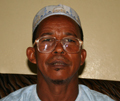Ajami in the Senegambia
by Fallou Ngom
Fula - Pulaar
Haal-pula(a)r (also called Fula, Fulfulde, and Fulani) is part of the West Atlantic branch of the Niger- Congo phylum. It is one of the most distributed languages in West Africa, besides the Mande language family. Pulaar, Pular, and Fulakunda are three varieties of Haal-pula(a)r. These three varieties are widely used in commerce, daily communication in their communities in both rural and urban areas and in the media. The Pulaar variety (also known as Toucouleur or Fuutankoore) is typically spoken in the Fuuta Tooro region. Fuuta Tooro (or Fouta Toro) was a major Pulaar geopolitical state, which has its seat in northern Senegal. It is also spoken in Mauritania, in The Gambia and some parts of Mali, Guinea, and Guinea Bissau (Ethnologue, 2005). The Pular variety of Haal-pula(a)r is typically referred to as the Fuuta Jalon (or Fuuta Jaloo) dialect is primarily spoken in Guinea and Sierra Leone. Its speakers are also found in several neighboring countries such as in Senegal, Mali, Guinea Bissau, and The Gambia, to name only a few. Pular is heavily used in commerce in many of these countries today. Fulakunda is the variety of Haal-pula(a)r primarily spoken in the present-day region of Kolda (known as Fuladu) in Casamance, Senegal. It is also spoken in neighboring Guinea Bissau and The Gambia. Some key features distinguish these three Fula varieties (among many). The morpheme /-aani/ is the perfective negative morpheme in the Fuuta Tooro and Fulakunda varieties, while the Fuuta Jalon variety typically uses the morpheme /-aali/. The Fuuta Jalon variety also favors sequences of oral vowels followed by the velar nasal /ŋ/ word-finally (similar to Senegambian Mandinka), while the Fuuta Tooro and Fulakunda varieties typically use sequences of oral vowels followed by the either the alveolar nasal /n/ or the bilabial nasal /m/ in similar positions. The Fulakunda variety stands out as the one variety with significant influence from Mandinka, one of the major languae francae in the Fuladu area of Casamance. While none of these languages is introduced in the public education systems, their Latin-based alphabets are now used in various adult literacy programs in Senegambia, particularly in rural areas, by both government and non-government organizations. Best evidence suggests that ajami is not yet included in any formal literacy program in the Senegambian sub-region. In general, while the Roman script is more commonly used in urban and rural areas where government and non-government literacy programs operate, ajami continues to be a major means of written communication in Muslim areas where these organizations have little presence. Because most speakers of these languages are Muslim, their languages also exhibit strong lexical influence from Arabic.


